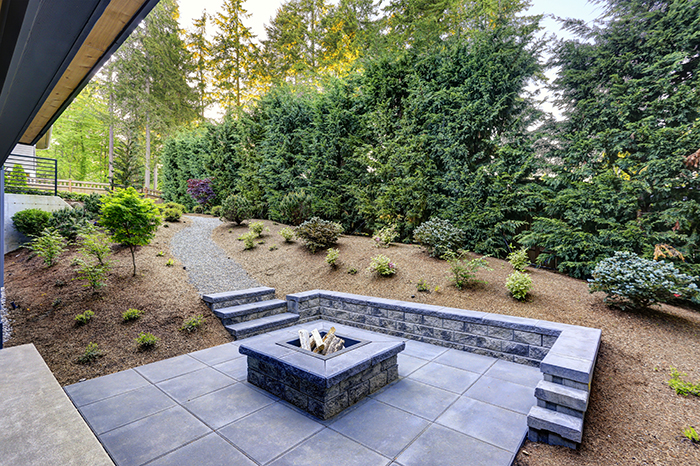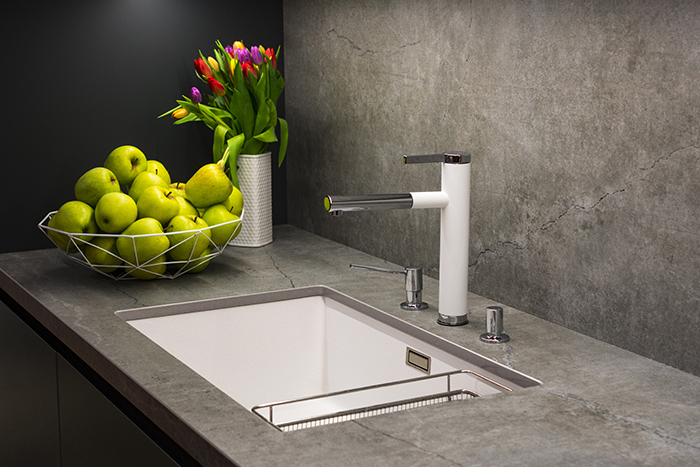Concrete Furniture and More
Concrete furniture?! Yep, you heard us right. Concrete is an incredible material that can be used to create beautiful tables, sinks, bookcases, and more. While most people think of concrete as a basic material for driveways and foundations, those of us in the know understand how perfect concrete is for crafting unique yet utilitarian furniture and household pieces.
What can you make with concrete?
Today, a more accurate question is what can’t you make with concrete? Concrete can be used to make so many durable objects. Let’s take a peek at some of our top ways to use concrete!
Concrete fire pits and tables
A concrete fire pit or fire table is one of our favorite ways to enhance an outdoor area. Homeowners love making the focus on their outdoor entertaining a fire pit or table, which is perfect for larger gatherings or a simple family night. Thanks to stamping and tinting options, a concrete fire pit can resemble more traditional materials and beautiful meld with any home style.
Concrete is a great option for fire pits since it’s unaffected by varied weather conditions, pests, or UV rays. Plus, concrete fire pits are low maintenance, requiring a simple soap and water cleaning periodically, if that! Many homeowners find that they don’t need to clean their concrete fire pits at all.
Use Proline’s Form and Edge Liners to make a custom fire pit or fire table for years of entertaining fun!

Concrete furniture
Concrete furniture is one of the most surprisingly elegant ways to use concrete. Consider benches, patio sets, interior/exterior tables, or side tables. Concrete’s durability is a major factor in its appeal. Concrete can withstand hundreds of pounds of weight, as well as extreme heat and cold. Plus, it’ll never warp.
Although concrete can develop minor cracks, they can be repaired. Cracks can be filled in with matching cement and a fresh coat of stain will refresh the look of the piece. Alternatively, minor cracks can be embraced with the viewpoint that they can enhance the natural beauty of the furniture!
With no off gassing, concrete is non-toxic and, with proper sealing, food safe too. Concrete is a great option for those with allergies, as it doesn’t permit the proliferation of mold, mildew, and dust mites.
Lastly, if you think concrete furniture is going to be heavy, then think again! Thanks to techniques like glass fiber reinforced concrete and hollow concrete, concrete furniture can be lighter than conventional materials but much stronger.
Concrete sinks
Concrete sinks are popular for their ability to compliment nearly any décor and style, as well as conform to just about any shape! No matter if you need a square, round, or rectangular shape, concrete is your go-to, especially if your sink has unconventional dimensions. Concrete works well for a traditional vanity as well as an elegant vessel sink. Concrete sinks are also a fantastic option if you’re installing a concrete countertop, too. This way, the countertop can meld seamlessly into the sink for a unified aesthetic.
Consider concrete sinks for both residential and commercial bathrooms or kitchens. They can be crafted in whatever dimensions are desired, whether that’s a deep trough sink or a double sink. Due to the vast options available with tinting and finishing, concrete can match nearly any look, from modern industrial to rustic farmhouse.
Concrete sinks must be sealed periodically in order to prevent staining and keep it in great condition. If minor damage occurs, it can generally be patched and resealed.

Why concrete?
Concrete is perfect for these less-conventional uses for the same reasons concrete is perfect for patios, walkways, and driveways!
Benefits of concrete
- Lasts for decades
- Low maintenance
- Lower life cycle cost
- Can be customized and designed
Concrete’s durability
Concrete can last for decades, especially if it’s properly installed and properly maintained. Although cracking and wearing can occur, most of this wear-and-tear can be patched and repaired.
Concrete’s maintenance needs
In general, concrete doesn’t need much in the way of maintenance. Regular cleaning with a mild detergent and stiff brush is usually sufficient. Depending on your concrete object, you might need to reapply sealers periodically to preserve colors and keep it looking great.
Life cycle cost of concrete
While the exact life cycle cost of concrete is dependent on what exactly the alternative is, in general, concrete wins out. It’s often more expensive up-front when compared to other materials but given concrete’s long life span and low maintenance needs, it ends up being the most cost-effective option.
Decorative concrete
Concrete really shines when it comes to decorative options and the ability to create fully customized pieces. While untextured concrete can work well for the options above, stamping concrete can make it mimic the look of brick, tile, stone, wood, and more.
Concrete might be pale gray, but that tone can take on a natural beauty of its own when polished to a high sheen. Or, consider the rainbow of tinting and staining options available by using antiquing washes, stains, integral color, and color hardeners.
To summarize:
- Concrete is more durable.
- Concrete has an average lifespan of 50 years.
- The only maintenance required is applying sealer every few years.
- Concrete can be stamped with patterns, textures, and designs
- Concrete can be tinted and stained with different colors and finishes.
Shop Calico Construction Products
Shop our selection of concrete stamps, form and edge liners, colors, and sealers. Contact our specialists at 800-221-9469 to discuss your project and any questions you have. If you’re a homeowner and you need to find a contractor in your area to perform the work, we can help there too!
Categories: Concrete Trends
